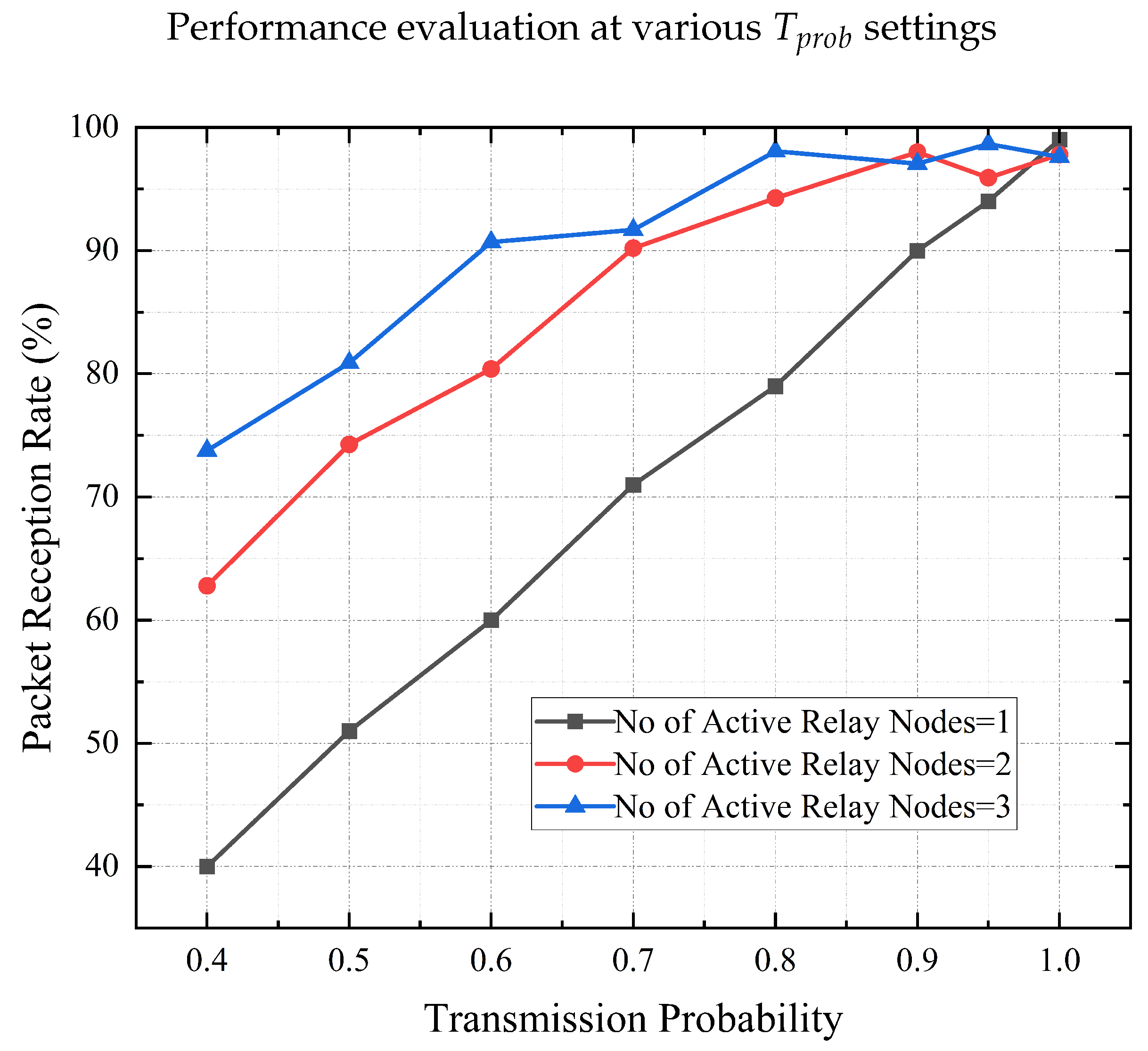Design Considerations and Performance Evaluation of Gossip Routing in LoRa-Based Linear Networks
Abstract
:1. Introduction
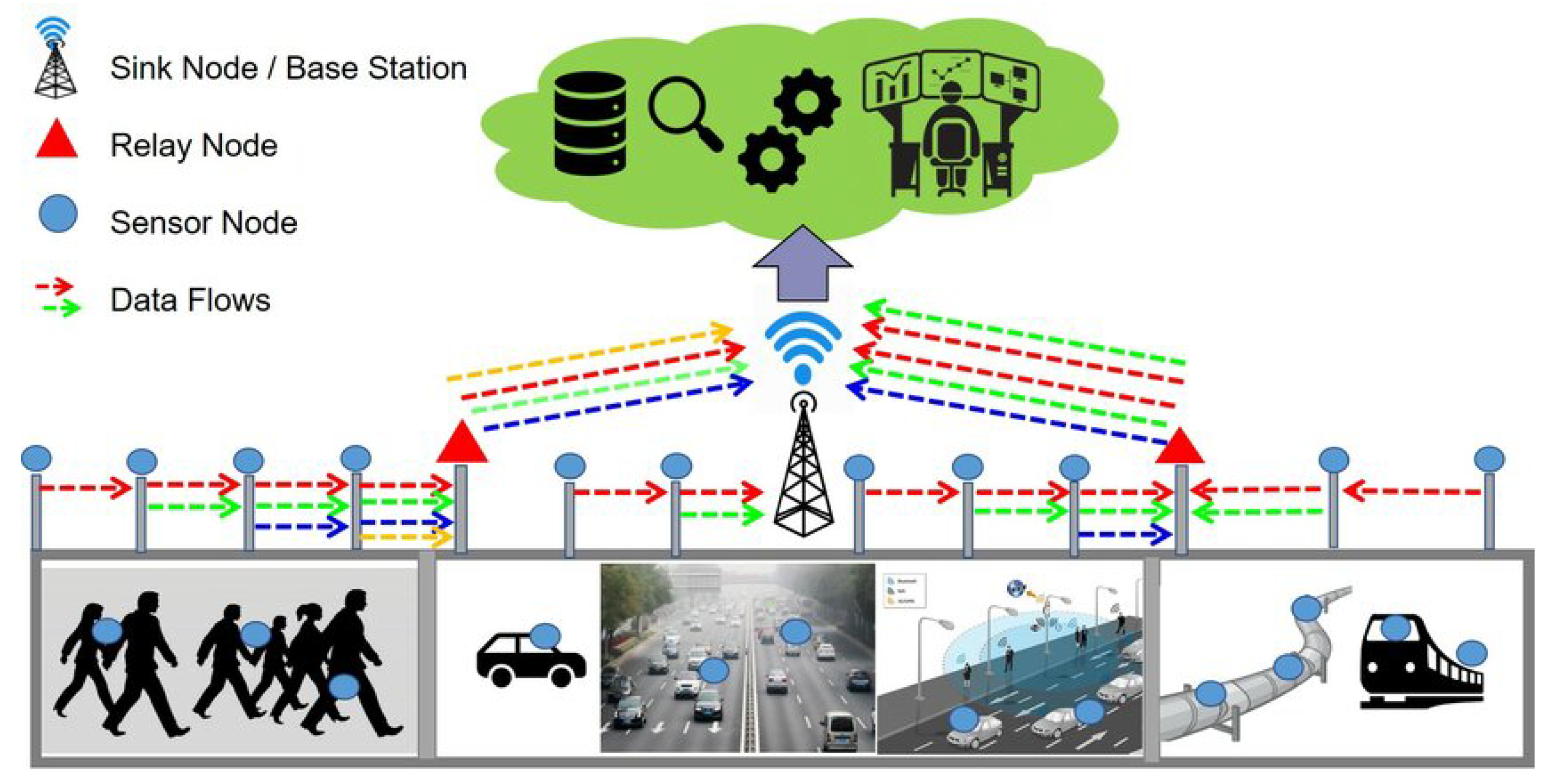
- We describe a simple and effective scheme to deal with contention within relays in linear networks that makes use of the fundamental behaviour of LoRa.
- We evaluated the performance of the approach in linear networks of up to three hops and up to a thickness of three nodes.
- We evaluated a gossip-routing-based approach applied to linear networks.
2. Related Work
3. Motivation
4. Experimental Setup
4.1. Coverage Estimation and Placement of Relay Nodes
4.2. Network Design and Configuration
- stands for Transmission probability;
- n stands for the number of relay nodes.
5. Result Evaluation and Discussion
5.1. Thin Linear Network
5.2. Linear Network of a Width of Two
5.3. Linear Network of a Width of Three
5.4. Gossip Routing
- Set up the network, and configure a transmitting node to continuously transmit at least 1000 packets, with a rate of 1 packet every four seconds.
- Relay nodes that relay packets to the destination node using various probabilities (1.00, 0.95, 0.90, 0.80, 0.70, 0.60, 0.50, 0.40).
- Re-run the experiments by configuring the relay nodes using various at the relay nodes.
- Compare the performance using two and three active relay nodes using a one-hop model.
5.5. Summary
6. Impact of Hardware Imperfection on Network Performance
7. Conclusions
Author Contributions
Funding
Data Availability Statement
Conflicts of Interest
References
- Liaqat, R.M.; Branch, P.; But, J. A Novel Approach to Collision Avoidance in LoRa Networks. In Proceedings of the 2023 Fourteenth International Conference on Ubiquitous and Future Networks (ICUFN), Paris, France, 4–7 July 2023; IEEE: Piscataway, NJ, USA; pp. 412–417. [Google Scholar]
- Marais, J.M.; Malekian, R.; Abu-Mahfouz, A.M. LoRa and LoRaWAN testbeds: A review. In Proceedings of the 2017 IEEE Africon, Cape Town, South Africa, 18–20 September 2017; pp. 1496–1501. [Google Scholar]
- Mekki, K.; Bajic, E.; Chaxel, F.; Meyer, F. A comparative study of LPWAN technologies for large-scale IoT deployment. ICT Express 2019, 5, 1–7. [Google Scholar] [CrossRef]
- Wang, H.; Liu, Y.; Wei, Y.; He, Y.; Tsang, K.F.; Lai, L.L.; Lai, C.S. LP-INDEX: Explore the best practice of LPWAN technologies in smart city. In Proceedings of the 2020 IEEE International Smart Cities Conference (ISC2), Virtual, 28 September–1 October 2020; IEEE: Piscataway, NJ, USA; pp. 1–5. [Google Scholar]
- Tresca, G.; Vista, F.; Boccadoro, P. Experimenting LoRa-compliant solutions in Real-World Scenarios. Internet Technol. Lett. 2020, 3, e136. [Google Scholar] [CrossRef]
- Liaqat, R.M.; Branch, P.; But, J. LoRa Based Linear Network Applications, Design Considerations and Open Challenges: A Review. In Proceedings of the 20th ACM Conference on Embedded Networked Sensor Systems, Boston, MA, USA, 6–9 November 2022; pp. 913–917. [Google Scholar]
- Acosta, C.E.; Gil-Castiñeira, F.; Costa-Montenegro, E.; Silva, J.S. Reliable link level routing algorithm in pipeline monitoring using implicit acknowledgements. Sensors 2021, 21, 968. [Google Scholar] [CrossRef] [PubMed]
- Centelles, R.P.; Freitag, F.; Meseguer, R.; Navarro, L. Beyond the star of stars: An introduction to multihop and mesh for LoRa and LoRaWAN. IEEE Pervasive Comput. 2021, 20, 63–72. [Google Scholar] [CrossRef]
- Kumar, A.S.; Gobinath, D.; Vijayakarthik, P.; Dhanasekaran, S.; Nithiyanandam, N.; Jeyalakshmi, V. An Effective Gas and Oil Leakage Detection System over Industrial Environment using Internet of Things Assistance. In Proceedings of the 2022 3rd International Conference on Electronics and Sustainable Communication Systems (ICESC), Coimbatore, India, 17–19 August 2022; IEEE: Piscataway, NJ, USA; pp. 1735–1742. [Google Scholar]
- Bouras, C.; Gkamas, A.; Kokkinos, V.; Papachristos, N. Using LoRa technology for IoT monitoring systems. In Proceedings of the 2019 10th International Conference on Networks of the Future (NoF), Rome, Italy, 1–3 October 2019; IEEE: Piscataway, NJ, USA; pp. 134–137. [Google Scholar]
- Kumar, P.P.; Paul, P.S.; Ananda, M. Development of LoRa Communication System for Effective Transmission of Data from Underground Coal Mines. Processes 2023, 11, 1691. [Google Scholar] [CrossRef]
- Sundaram, J.P.S.; Du, W.; Zhao, Z. A survey on lora networking: Research problems, current solutions, and open issues. IEEE Commun. Surv. Tutor. 2019, 22, 371–388. [Google Scholar] [CrossRef]
- Jabbari, A.; Ayinala, K.; Almalki, K.J.; Sung, S.; Choi, B.Y.; Song, S. Building an energy efficient linear sensor (EELS) infrastructure for smart cities. In Proceedings of the 2019 IEEE International Smart Cities Conference (ISC2), Casablanca, Morocco, 14–17 October 2019; IEEE: Piscataway, NJ, USA; pp. 665–670. [Google Scholar]
- Citoni, B.; Ansari, S.; Abbasi, Q.H.; Imran, M.A.; Hussain, S. Comparative analysis of an urban lorawan deployment: Real world versus simulation. IEEE Sens. J. 2022, 22, 17216–17223. [Google Scholar] [CrossRef]
- Rady, M.; Muñoz, J.; Abu-Aisheh, R.; Vučinić, M.; Astorga Tobar, J.; Cortes, A.; Lampin, Q.; Barthel, D.; Watteyne, T. A Historical Twist on Long-Range Wireless: Building a 103 km Multi-Hop Network Replicating Claude Chappe’s Telegraph. Sensors 2022, 22, 7586. [Google Scholar] [CrossRef]
- Fernandes, R.; Oliveira, R.; Luís, M.; Sargento, S. On the real capacity of LoRa networks: The impact of non-destructive communications. IEEE Commun. Lett. 2019, 23, 2437–2441. [Google Scholar] [CrossRef]
- Thirumal, G.; Kumar, C. Multilevel sensor deployment approach in IIoT-based environmental monitoring system in underground coal mines. Comput. Commun. 2022, 195, 1–13. [Google Scholar] [CrossRef]
- Muduli, L.; Mishra, D.P.; Jana, P.K. Application of wireless sensor network for environmental monitoring in underground coal mines: A systematic review. J. Netw. Comput. Appl. 2018, 106, 48–67. [Google Scholar] [CrossRef]
- Alhomyani, H.; Fadel, M.; Dimitriou, N.; Bakhsh, H.; Aldabbagh, G.; Alkhuraiji, S. Multi-Hop Routing Protocols for Oil Pipeline Leak Detection Systems. Electronics 2022, 11, 2078. [Google Scholar] [CrossRef]
- Fang, W.; Wang, X.; Xu, H. An Extended PEGASIS Protocol Based on Group Authentication with Merkle Tree in WSNs. J. Physics: Conf. Ser. 2019, 1314, 012175. [Google Scholar] [CrossRef]
- He, S.; Wang, J.; Sun, Z. An improved wireless sensor network for natural gas monitoring. In Proceedings of the 2018 Chinese Automation Congress (CAC), Xi’an, China, 30 November–2 December 2018; IEEE: Piscataway, NJ, USA; pp. 2542–2547. [Google Scholar]
- Abrardo, A.; Fort, A.; Landi, E.; Mugnaini, M.; Panzardi, E.; Pozzebon, A. Black powder flow monitoring in pipelines by means of multi-hop LoRa networks. In Proceedings of the 2019 II Workshop on Metrology for Industry 4.0 and IoT (MetroInd4. 0&IoT), Naples, Italy, 4–6 June 2019; IEEE: Piscataway, NJ, USA; pp. 312–316. [Google Scholar]
- Xu, W.; Cai, G.; Fang, Y.; Chen, G. Performance analysis of a two-hop relaying LoRa system. In Proceedings of the 2021 IEEE/CIC International Conference on Communications in China (ICCC), Xiamen, China, 28–30 July 2021; IEEE: Piscataway, NJ, USA; pp. 540–545. [Google Scholar]
- Nguyen, N.H.; Mai, D.L.; Kim, M.K. Performance Evaluation of Linear LoRa Network Protocol. In IT Convergence and Security; Springer: Berlin/Heidelberg, Germany, 2021; pp. 69–76. [Google Scholar]
- Cotrim, J.R.; Margi, C.B.; Kleinschmidt, J.H. Design of a Gateway-based relay node for LoRaWAN multihop networks. In Proceedings of the 2022 Symposium on Internet of Things (SIoT), Sao Paulo, Brazil, 24–28 October 2022; IEEE: Piscataway, NJ, USA; pp. 1–4. [Google Scholar]
- Cotrim, J.R.; Kleinschmidt, J.H. An analytical model for multihop LoRaWAN networks. Internet Things 2023, 22, 100807. [Google Scholar] [CrossRef]
- Basili, F.; Parrino, S.; Peruzzi, G.; Pozzebon, A. Iot multi-hop facilities via lora modulation and lora wanprotocol within thin linear networks. In Proceedings of the 2021 IEEE Sensors Applications Symposium (SAS), Sundsvall, Sweden, 23–25 August 2021; IEEE: Piscataway, NJ, USA; pp. 1–6. [Google Scholar]
- Ferretti, D.; Lanci, P.; Torun, B.; Amato, D.; Verdone, R. LoRa-Based Railway Signalling System for Secondary Lines. In Proceedings of the 2022 61st FITCE International Congress Future Telecommunications: Infrastructure and Sustainability (FITCE), Rome, Italy, 29–30 September 2022; IEEE: Piscataway, NJ, USA; pp. 1–6. [Google Scholar]
- Sardar, M.S.; Xuefen, W.; Yi, Y.; Kausar, F.; Akbar, M.W. Wireless underground sensor networks. Int. J. Perform. Eng. 2019, 15, 3042. [Google Scholar]
- Kanthavel, R.; Indra Priyadharshini, S.; Sudha, D.; Sundara Velrani, K.; Dhaya, R. Multi-hoped cooperative communication-based wireless underground sensor network design. Int. J. Commun. Syst. 2022, 35, e5174. [Google Scholar] [CrossRef]
- Branch, P.; Cricenti, T. A LoRa relay based system for detonating explosives in underground mines. In Proceedings of the 2020 IEEE International Conference on Industrial Technology (ICIT), Buenos Aires, Argentina, 26–28 February 2020; IEEE: Piscataway, NJ, USA; pp. 259–264. [Google Scholar]
- Branch, P.; Cricenti, T. A LoRa based wireless relay network for actuator data. In Proceedings of the 2020 International Conference on Information Networking (ICOIN), Barcelona, Spain, 7–10 January 2020; IEEE: Piscataway, NJ, USA; pp. 190–195. [Google Scholar]
- Calle, M.; Berdugo, G.; Velez, J.C.; Kabara, J. MACGSP6: A protocol for supporting internet of things applications with Non-Line-of-Sight links. Comput. Electr. Eng. 2017, 58, 76–87. [Google Scholar] [CrossRef]
- Bhushan, B.; Sahoo, G. Routing protocols in wireless sensor networks. In Computational Intelligence in Sensor Networks; Intechopen: London, UK, 2019; pp. 215–248. [Google Scholar]
- Kundaliya, B.L.; Hadia, S.K. Routing algorithms for wireless sensor networks: Analysed and compared. Wirel. Pers. Commun. 2020, 110, 85–107. [Google Scholar] [CrossRef]
- Patra, C.; Botezatu, N. Effect of gossiping on some basic wireless sensor network protocols. In Proceedings of the 2017 21st International Conference on System Theory, Control and Computing (ICSTCC), Sinaia, Romania, 19–21 October 2017; IEEE: Piscataway, NJ, USA; pp. 309–314. [Google Scholar]
- Saha, S.; Sayed, M.I.; Das, P.; Mukherjee, B. SIG: A Gossip based energy efficient routing protocol for WSN. Int. J. Adv. Netw. Appl. 2022, 13, 5108–5112. [Google Scholar] [CrossRef]
- Kenyeres, M.; Kenyeres, J. Comparative study of distributed consensus gossip algorithms for network size estimation in multi-agent systems. Future Internet 2021, 13, 134. [Google Scholar] [CrossRef]
- Chatterjee, M.; Mitra, A.; Setua, S.K.; Roy, S. Gossip-based fault-tolerant load balancing algorithm with low communication overhead. Comput. Electr. Eng. 2020, 81, 106517. [Google Scholar] [CrossRef]
- Nakas, C.; Kandris, D.; Visvardis, G. Energy efficient routing in wireless sensor networks: A comprehensive survey. Algorithms 2020, 13, 72. [Google Scholar] [CrossRef]
- Osorio, A.; Calle, M.; Soto, J.; Candelo-Becerra, J.E. Routing in LoRa for smart cities: A gossip study. Future Gener. Comput. Syst. 2022, 136, 84–92. [Google Scholar] [CrossRef]
- Bhuyar, A.R.; Khan, S.Z. A Review on Effective Mechanism to Reduce Routing Overhead in Mobile Ad Hoc Network. Int. J. Emerg. Trends Eng. Basic Sci. 2020, 7, 222–228. [Google Scholar]
- Kifle, D.; Gianini, G.; Libsie, M. Improving probabilistic flooding using topological indexes. In Proceedings of the 2019 15th International Conference on Signal-Image Technology & Internet-Based Systems (SITIS), Sorrent, Italy, 26–29 November 2019; IEEE: Piscataway, NJ, USA; pp. 376–382. [Google Scholar]
- Liao, C.H.; Zhu, G.; Kuwabara, D.; Suzuki, M.; Morikawa, H. Multi-hop LoRa networks enabled by concurrent transmission. IEEE Access 2017, 5, 21430–21446. [Google Scholar] [CrossRef]
- Gloria, A.; Dionisio, C.; Simões, G.; Sebastião, P. LoRa Transmission Power Self Con? Guration for Low Power End Devices. In Proceedings of the 2019 22nd International Symposium on Wireless Personal Multimedia Communications (WPMC), Lisbon, Portugal, 24–27 November 2019; IEEE: Piscataway, NJ, USA; pp. 1–6. [Google Scholar]
- Bor, M.; Roedig, U. LoRa transmission parameter selection. In Proceedings of the 2017 13th International Conference on Distributed Computing in Sensor Systems (DCOSS), Ottawa, ON, Canada, 5–7 June 2017; IEEE: Piscataway, NJ, USA; pp. 27–34. [Google Scholar]







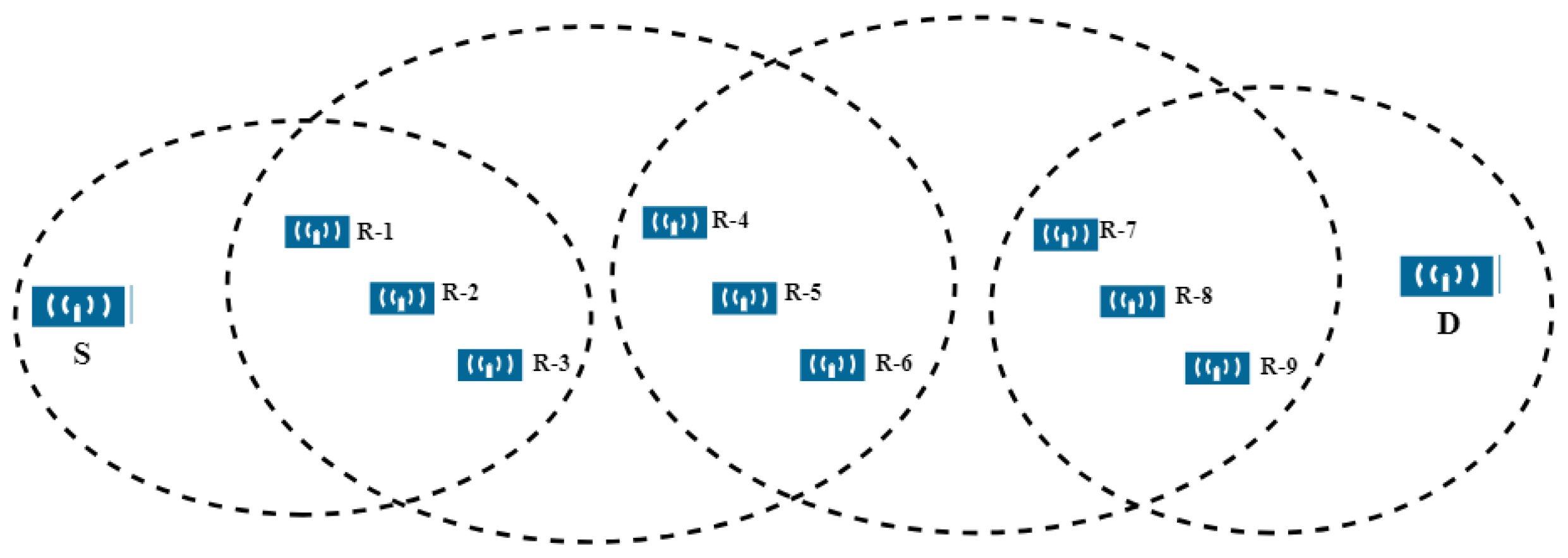

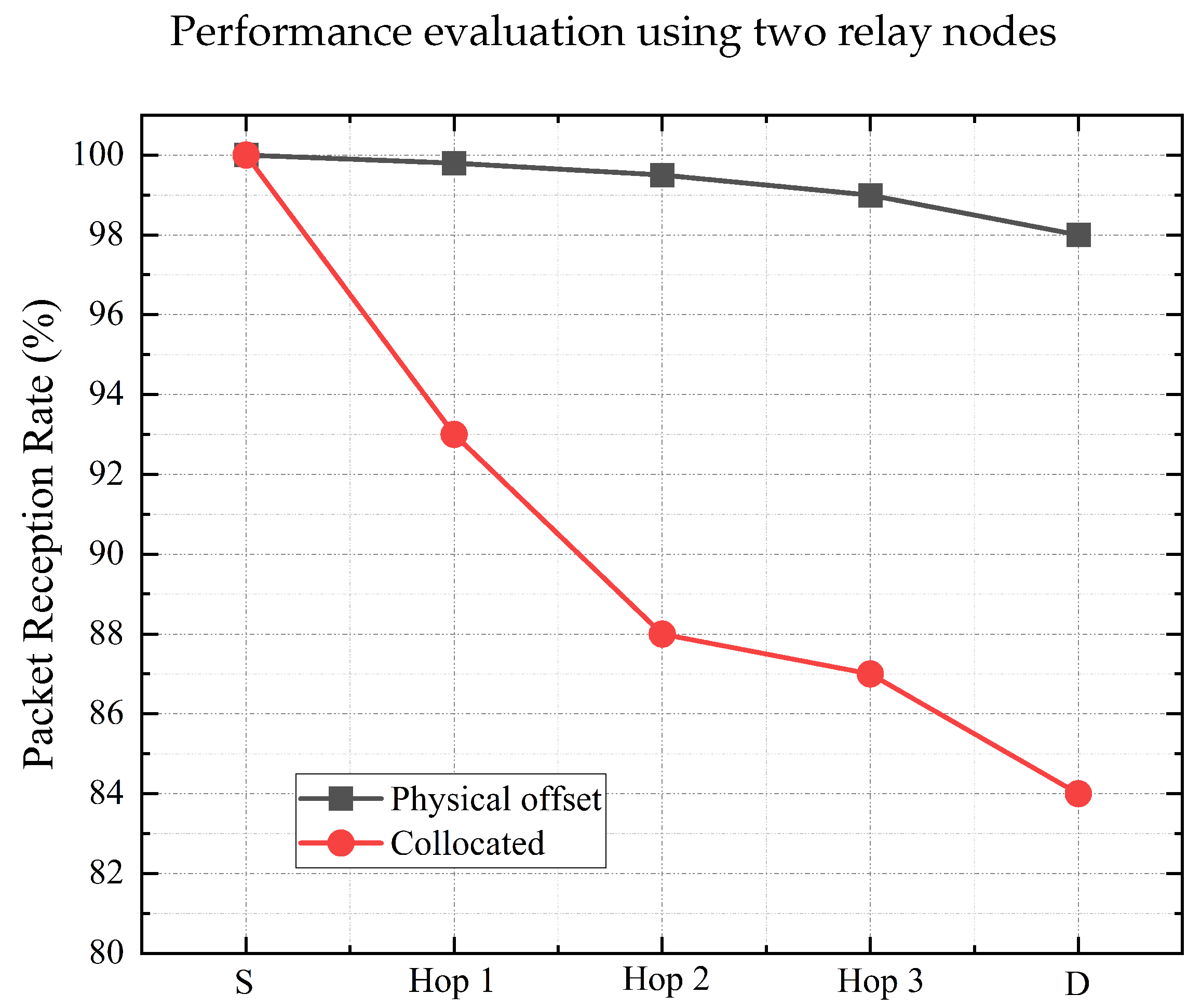
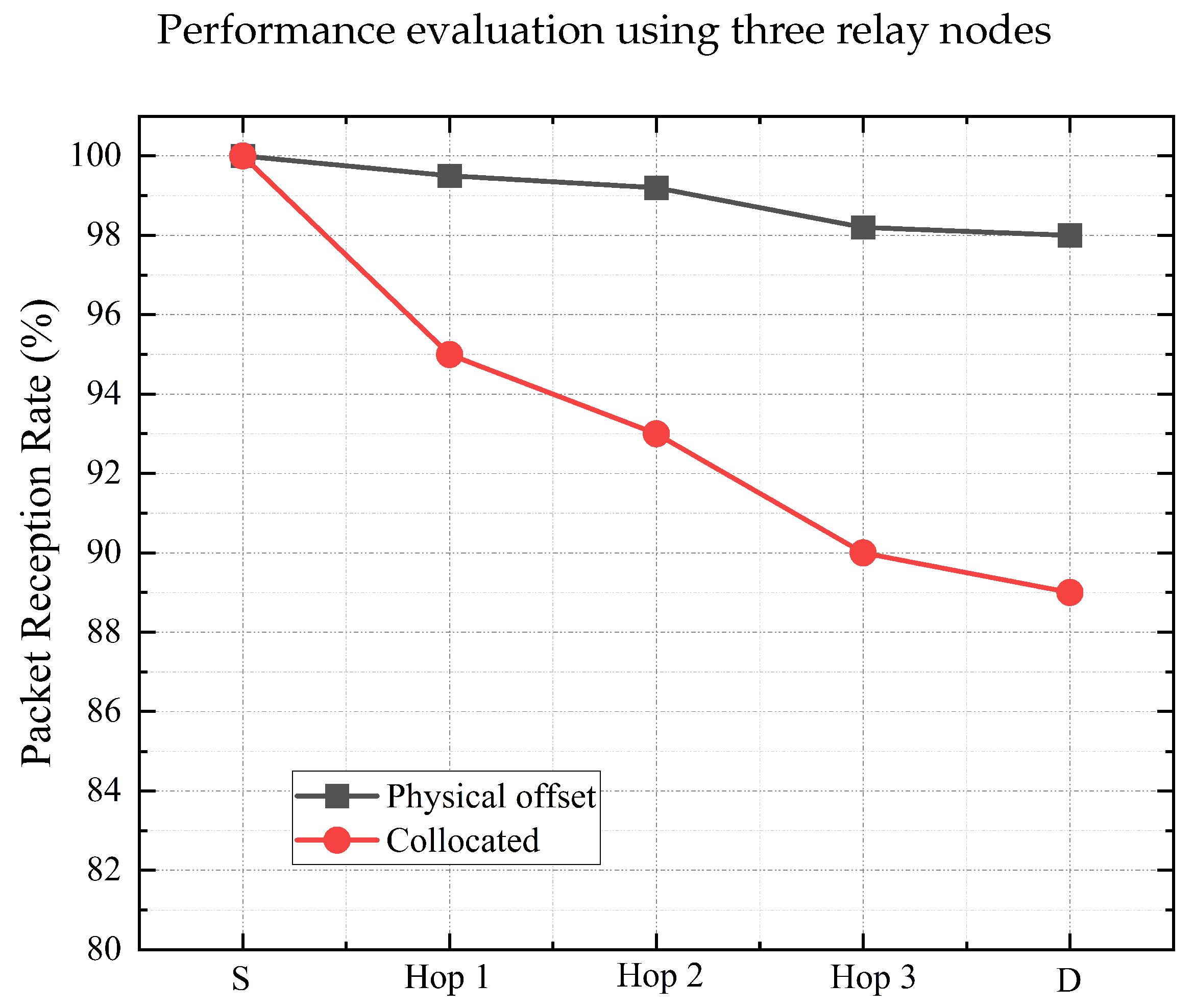
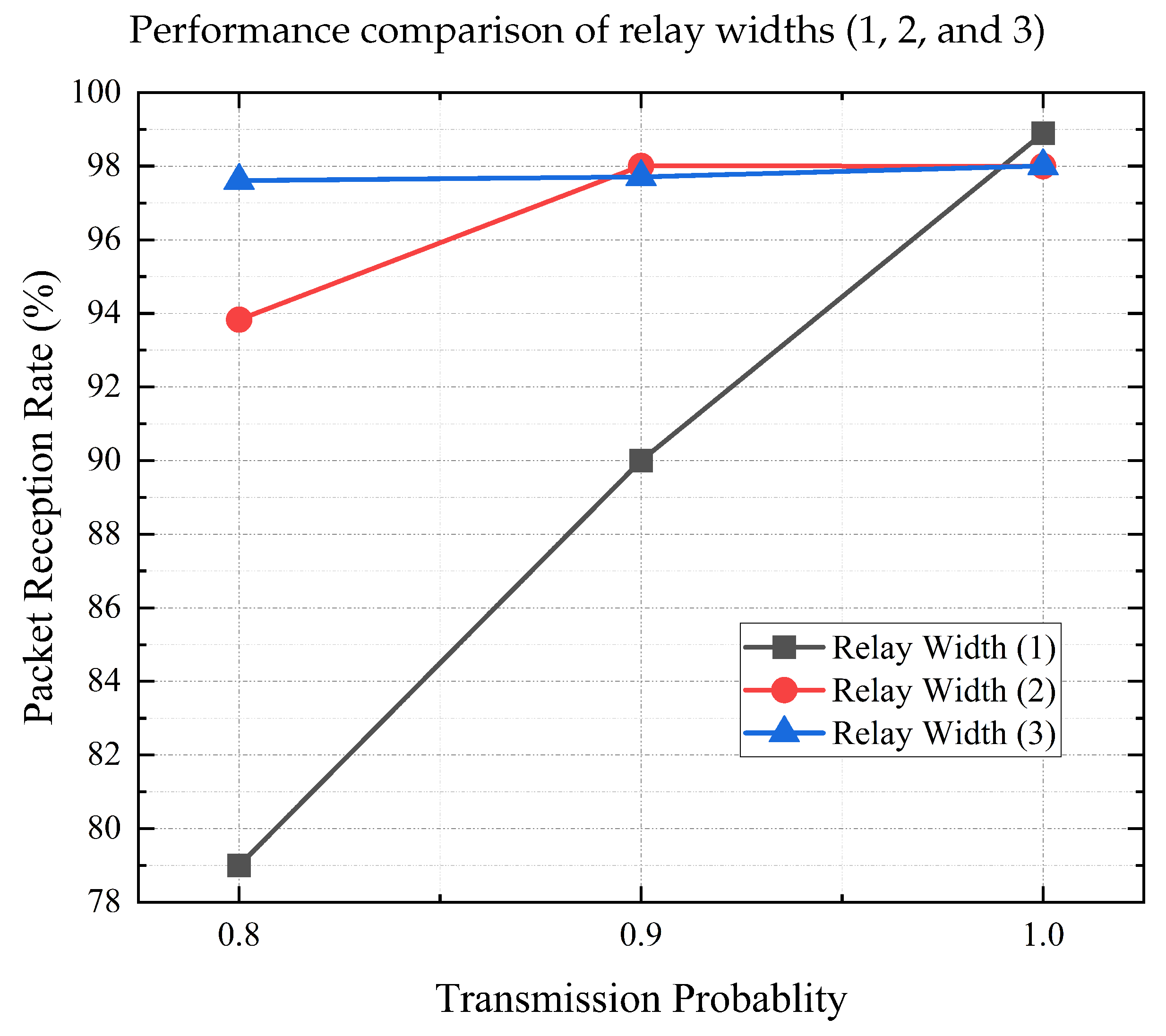
| Parameter | Value |
|---|---|
| Packet Size | 10 Bytes |
| Transmission Power (TP) | 14 dBm |
| Spreading Factor (SF) | 7 |
| Bandwidth (BW) | 500 kHz |
| Coding Rate (CR) | 4/5 |
| 1.00 | 0.95 | 0.90 | 0.80 | 0.70 | 0.60 | 0.50 | 0.40 | |
|---|---|---|---|---|---|---|---|---|
| Ideal | 100.00% | 99.75% | 99.00% | 96.00% | 91.00% | 84.00% | 75.00% | 64.00% |
| Experiment 1 | 96.21% | 93.43% | 98.00% | 94.72% | 90.54% | 80.99% | 73.73% | 61.99% |
| Experiment 2 | 99.40% | 98.40% | 98.01% | 93.83% | 89.86% | 79.82% | 74.82% | 63.61% |
| Average | 97.80% | 95.91% | 98.00% | 94.27% | 90.20% | 80.40% | 74.27% | 62.81% |
| 1.00 | 0.95 | 0.90 | 0.80 | 0.70 | 0.60 | 0.50 | 0.40 | |
|---|---|---|---|---|---|---|---|---|
| Ideal | 100.00% | 99.98% | 99.90% | 99.20% | 97.30% | 93.60% | 87.50% | 78.40% |
| Experiment 1 | 98.90% | 99.00% | 97.71% | 97.61% | 91.24% | 91.14% | 81.29% | 74.02% |
| Experiment 2 | 96.31% | 98.31% | 96.41% | 98.51% | 92.13% | 90.24% | 80.49% | 73.53% |
| Average | 97.60% | 98.65% | 97.06% | 98.06% | 91.68% | 90.69% | 80.89% | 73.77% |
| Source Arduino Board | Destination Arduino Board | Source LoRa Shield | Destination LoRa Shield | RSSI | SNR |
|---|---|---|---|---|---|
| Arduino UNO | Arduino UNO | H RF96 | H RF96 | −40 | 5 |
| Arduino UNO (Micro USB) | Arduino UNO (Micro USB) | H RF96 | H RF96 | −35 | 5 |
| Arduino UNO | Arduino UNO | SX 1276 | SX 1276 | −35 | 5 |
| Arduino UNO (Micro USB) | Arduino UNO (Micro USB) | SX 1276 | SX 1276 | −77 | 5 |
| Arduino UNO | Arduino UNO | H RF96 | SX 1276 | −35 | 5 |
| Arduino UNO (Micro USB) | Arduino UNO (Micro USB) | H RF96 | SX 1276 | −40 | 5 |
| Arduino Boards | LoRa Shields | RSSI | SNR | |
|---|---|---|---|---|
| Node 1 | Arduino UNO | SX 1276 | −35 (via 1 to 3) | 5 (via 1 to 3) |
| Node 2 | Arduino UNO | SX 1276 | −60 (via 1 to 3) | 5 (via 2 to 3) |
| Node 3 | Arduino UNO | SX 1276 | −65 (via 1 to 3) | 5 (via 1 to 2) |
Disclaimer/Publisher’s Note: The statements, opinions and data contained in all publications are solely those of the individual author(s) and contributor(s) and not of MDPI and/or the editor(s). MDPI and/or the editor(s) disclaim responsibility for any injury to people or property resulting from any ideas, methods, instructions or products referred to in the content. |
© 2023 by the authors. Licensee MDPI, Basel, Switzerland. This article is an open access article distributed under the terms and conditions of the Creative Commons Attribution (CC BY) license (https://creativecommons.org/licenses/by/4.0/).
Share and Cite
Liaqat, R.M.; Branch, P.; But, J. Design Considerations and Performance Evaluation of Gossip Routing in LoRa-Based Linear Networks. Future Internet 2023, 15, 366. https://doi.org/10.3390/fi15110366
Liaqat RM, Branch P, But J. Design Considerations and Performance Evaluation of Gossip Routing in LoRa-Based Linear Networks. Future Internet. 2023; 15(11):366. https://doi.org/10.3390/fi15110366
Chicago/Turabian StyleLiaqat, Rao Muzamal, Philip Branch, and Jason But. 2023. "Design Considerations and Performance Evaluation of Gossip Routing in LoRa-Based Linear Networks" Future Internet 15, no. 11: 366. https://doi.org/10.3390/fi15110366
APA StyleLiaqat, R. M., Branch, P., & But, J. (2023). Design Considerations and Performance Evaluation of Gossip Routing in LoRa-Based Linear Networks. Future Internet, 15(11), 366. https://doi.org/10.3390/fi15110366







